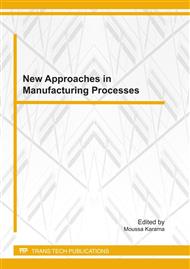p.1
p.11
p.21
p.37
p.49
p.57
p.67
p.77
Coupling of Adapting Remeshing and Projection Techniques for Numerical Simulations of Forming Processes
Abstract:
As soon as it is question of modelling the follow-up of a geometry during an operation of forming process, the difficulties of meshing and remeshing are often emphases. If the part is situated between rigid tools (case of the deep drawing), in the problems of remeshing are also added difficulties on the management of the contact between the parts. In this case, the deformations are caused by the contact with the tools whose geometry are fixed. The piece must take the shape of the tool geometries during the deformation. In this paper, we present a method coupling an adaptive remeshing strategy and a technique of projection on the tool. The remeshing is based on refinement and coarsening procedures. The projection of the new nodes on the tool allows keeping the contact between the part and the tools. Numerical examples show the efficiency of the method.
Info:
Periodical:
Pages:
1-10
Citation:
Online since:
June 2011
Authors:
Keywords:
Price:
Сopyright:
© 2011 Trans Tech Publications Ltd. All Rights Reserved
Share:
Citation:


